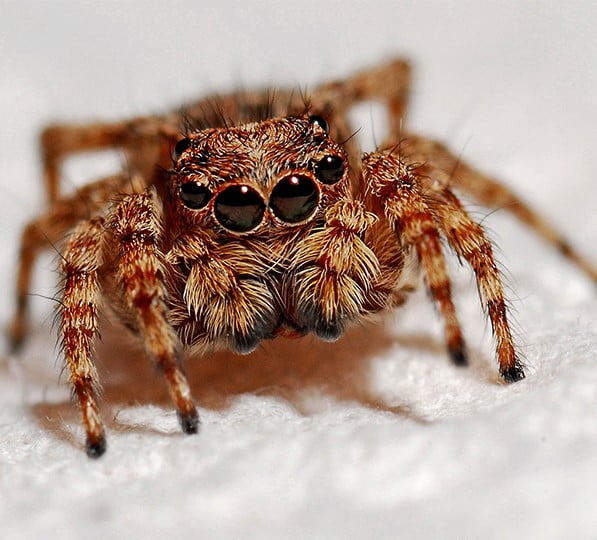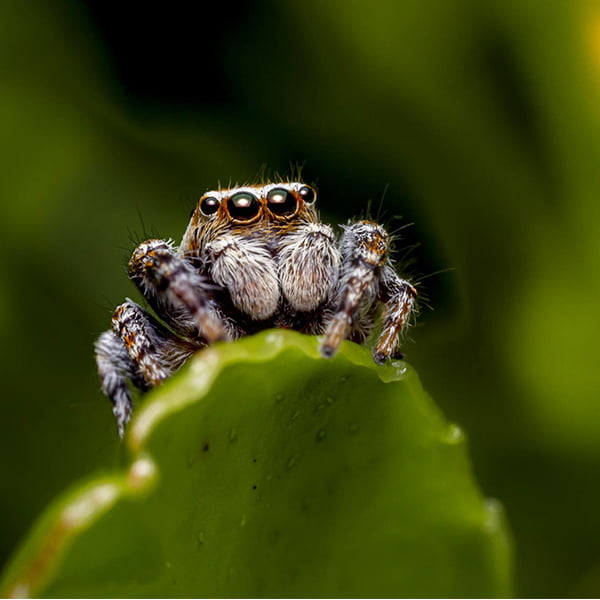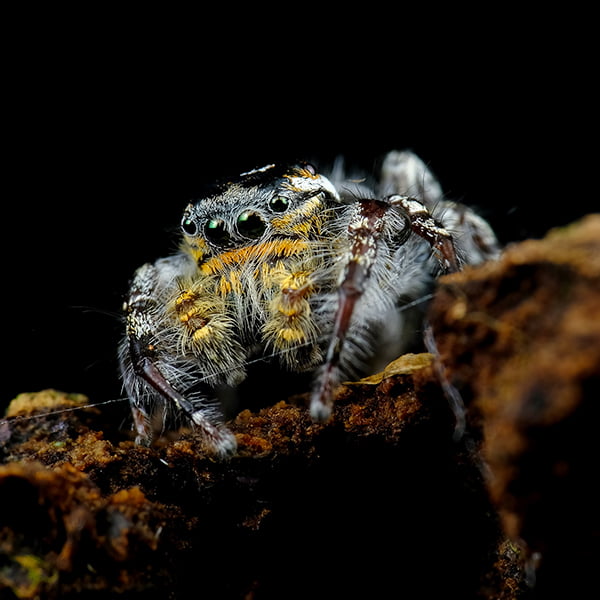The regal jumping spider is becoming popular as a pet. This easy-going, cheery little spider has very simple care needs and makes a great pet for amateur arachnid handlers. They are large and thus easier to handle and have easy-going and friendly personalities.
Is it time for you to get one of these cute little jumping spiders? How hard is a regal jumping spider to take care of? Are regal jumping spiders dangerous? Let's find out.
Name And Origin of Regal Jumping Spiders
The Regal Jumping Spider belongs to one of 6,000 different species of jumping spiders found in the wild. A regal jumping spider scientific name is the Phidippus regius, which can be found in regions all over the world but is most commonly seen in the southeastern United States, in states like Georgia, Florida, and even Texas. They can also be found in the Bahamas and the Great Antilles.
They are the largest of the jumping spider species found in eastern North America. They are named for their large size and for their preferred hunting style. These spiders can jump up to 9x their body length, making them efficient hunters. As a pan-tropical species, these spiders most often frequent the humid hot woodlands and field habitats of the south.
Appearance and Size
The regal jumping spider is the largest jumping spider in the eastern US. Like other jumping spider species, they exhibit sexual dimorphism, which means that males and females have different appearances.
Females are larger than males and can grow between 7 and 22mm long. Adult males are only slightly smaller at 6-18mm full grown length. Females are either grey or orange-bodied with black stripes and spots, and males are black with white stripes and dots.
Tiny hairs give the regal jumping spider a fuzzy appearance and, when paired with their large eyes, make them some of the cutest spiders to own. Even dots on the spider's abdomen look like smiling faces, adding to the charm of these lovable arachnids.
Expectancy
In the wild and in captivity, a regal jumping spider lifespan is between 1-3 years.
Housing
A regal jumping spider does not take up a lot of space, and you should get a container with a capacity of about 1 gallon or approximately 6x6x10 inches. Regal jumping spiders prefer vertical space, so be sure that your tank is at least 10 inches high.
You do not want a tank much larger than this; otherwise, your spider will have difficulty finding its food.
This space should be big enough for your spider to explore and exercise. Because regal jumping spiders love climbing and jumping, you should provide lots of objects for your spider to play on. Add branches, twigs, leaves, plants, and rocks for enrichment. It also helps them build silken nests at night, where they will sleep, molt and egg-laying.
The tank can be glass, plastic, or even wood, so long as it allows for proper ventilation while still ensuring your jumping spider can't escape.

Source: Pikwizard
Behavior & Temperament
One of the reasons regal jumping spiders make such good pets is just how easy-going and friendly they are. These spiders generally enjoy being handled and may even learn to recognize their handlers. They are daytime spiders and will explore and play during the day or hide if they are shy or nervous. A jumping spider will build nests and climb and, even in captivity, will jump to catch prey at mealtimes.
Jumping spiders are not prone to being, but they will if they feel threatened. They will always try to escape first though, before biting. Even if you are a bit, their bite doesn't usually break the skin; even if it does, their venom is not serious to humans. There will be some mild pain and perhaps swelling, but at most will just be a bit uncomfortable. You can use gloves when handling your spider until you are more comfortable in the beginning.
Heat & Humidity
Regal jumping spiders like it warm and humid. 75-82ºF is the ideal temperature range, and since many homes are already in this range, it is generally unnecessary to have a heating element. If you live in a cold climate, however, rather than using a heating pad or direct light, use a space heater to bring up the temperature of the entire room naturally. It would help if you never put your tank in direct sunlight, which can quickly overheat the spider.
For humidity, use a mister twice daily to maintain a humidity of about 50-60%. A shallow bowl can also be placed in the tank to maintain humidity.
Light
Regal jumping spiders love the light and will need at least five hours every day under an overhead LED light that won't heat up the cage. Direct sunlight will overheat a tank, especially glass or plastic tanks, so it is best to use artificial light.
Feeding
Regal jumping spiders eat insects and, in captivity, can thrive on a simple diet of crickets and mealworms. Babies two months or less should be fed pinhead crickets or flightless fruit flies, but once they reach maturity, the basic rule is that they can eat anything so long as the length of the prey does not exceed that of the spider.
You should feed your regal spider as much as you can three times a week. At mealtimes, keep offering your regal spider insects until they won't eat anymore, and then remove anything uneaten. For most adult regal spiders, this will amount to between 1 and 3 crickets or mealworms. A healthy spider will always have a good appetite, so use this time as a way to gauge your spider's overall health.
Water
Dehydration is a common issue with regal jumping spiders, so you must be sure that your spider always has water. A dehydrated spider will have a shriveled and wrinkled abdomen. Hydration is best provided by regular misting and maintaining a humidity of 50% and higher in the tank at all times.
Substrate
The only rule for the substrate you should use in your spider's tank is that it holds moisture well and so helps maintain humidity. It should also be soft so that if your spider falls, it is not hurt, and coconut fiber is good for this. The substrate should be two inches deep, and you should ensure sufficient ventilation to prevent mold growth.

Source: Pixabay
Gender Identification
Regal jumping spiders are considered dimorphic, meaning that the sexes are noticeably different and thus very easy to identify.
Female Regal jumping spiders
Female regal jumping spiders tend to be larger, with chunkier bodies. They are always either grey or orange. Adult females have a distinct black band on their legs and a marking on their abdomen.
Male Regal Jumping Spiders
On the other hand, a male regal jumping spider tends to be smaller and more slender with a black or very dark grey body. You can also identify males by looking at their chelicerae or the spider's jaws, and they possess enlarged iridescent chelicerae that help females visually identify males.

Source: Freepik
Common Health and Behavior Problems
Regal jumping spiders are prone to a few health issues, most of which there is no real cure or help for. Once a spider gets sick, it usually doesn't make it, and there is little science yet for spider treatments. A few of the most commonly seen issues include—
Dehydration
One of the main health issues of a regular jumping spider face is dehydration. Usually it is due to too low humidity for too long.
Your spider may be dehydrated if its abdomen looks shriveled like a raisin instead of firm and round. They may also experience trouble shedding their exoskeleton and even use limbs during a shed.
To prevent dehydration, ensure there is 50% to 60% humidity in their enclosure. Anything below 50% can cause dehydration. It's best to mist their enclosure twice daily to help keep the humidity up and prevent dehydration.
Heatstroke
If the tank overheats due to improper lighting or direct sunlight, a regal jumping spider can suffer from heatstroke. While most spiders do not survive heat stroke, you can try to save your spider by providing ample humidity and keeping their enclosure warm but not hot.
Mismolt
Mismolt is when a spider fails to shed their exoskeleton correctly while molting. If this occurs, there is not much you can do, as their new exoskeleton is extremely soft. Do not attempt to "help" them shed as you can cause more damage and even death. If your spider is struggling, provide extra humidity, which can help in some cases.
Failure to thrive
Failure to thrive is a condition in which baby spiders cannot eat and grow. There is not much you can do as the cause is unknown.
Drowning
Most common in spiderlings. There is little you can do to help. Carefully place the spider on a paper towel so it can absorb enough water to save it.
With spiderlings, it's best to provide water with a soaked paper towel or other material other than water droplets.
Passive recessive disorder
A condition, most likely genetic, is when the spiders turn white and have the characteristics that occur in both a male and female regal jumping spider. These spiders generally have many behavioral issues and often have to be hand fed, and they usually die during or after their final molt.
